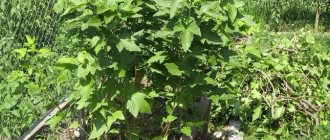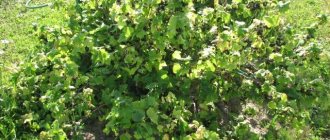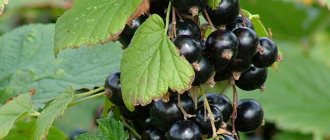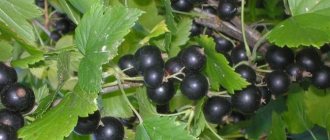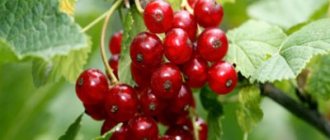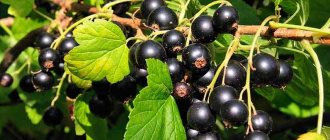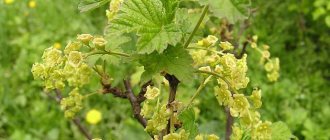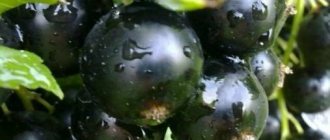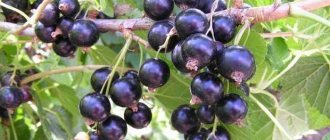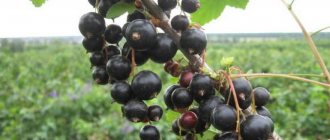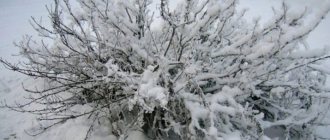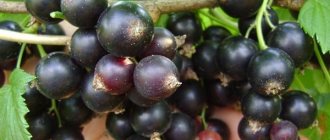History of variety selection
Black currant variety Green Haze is a hybrid plant created by breeders T.S. Zvyagin. and Sergeev K.D. at VNIIS named after. Michurina. To create the variety, the institute's staff crossed two well-known varieties of currants - Minai Shmyrev and Karelskaya.
After the hybrid was entered into the State Register in 2004, the variety began to actively spread throughout Russia. Experts note high currant yields even in regions such as Eastern and Western Siberia, the Black Earth Region, the Urals, and the Central and Western districts of the country.
How to care for Green Haze
Plant care involves watering, fertilizing, loosening, and mulching the soil.
Watering and timely fertilizing
Currant is a moisture-loving plant. If there is not enough rainfall, the bushes are additionally moistened. Considering that the plants are planted in fertilized soil, fertilizing is carried out in the 3rd year after planting. In spring they fertilize with nitrogen, in summer and autumn - with a complex composition.
See also
Description and characteristics of black currant variety Dachnitsa, planting and care
Read
Loosening and mulching the soil
After watering, the soil is loosened to prevent crust formation. It will prevent air from reaching the root system. To retain moisture, the root circle is sprinkled with mulch.
Formative trimming
Removing excess branches helps to increase fruiting due to the access of air and sun inside the bush. The first pruning is done already at planting: the shoots are pruned to 2-3 buds. Due to this, a branched bush will form next year. Branches that have reached 5 years of age are cut out completely, since they grow few berries.
Preventative treatments
To prevent the appearance of diseases and pests, bushes are irrigated with insectofungicides in early spring. When the leaves and buds begin to bloom, the currants are inspected and, if necessary, sprayed again. It is important to remember that the procedure is carried out before the plants bloom.
Do I need to cover it for the winter?
Although Green Haze is a winter-hardy variety, in the northern regions currants need to be covered. For this, burlap and a special film are used. Before the onset of frost, the bushes are hilled to a height of 15-20 centimeters.
Description of the currant variety Green Haze
The hybrid belongs to the mid-season type of black currant. Spreading is small, the height of mature bushes is average. Young shoots are straight, bright green in color. After lignification they become light yellow in color.
The leaves of the bushes do not differ in shape from other varieties of blackcurrant. Quite large, without growths, smooth, slightly wrinkled, light green in color, five-lobed in shape.
Unlike the leaves, the flowers of the hybrid are small in size, resembling a glass. The sepals are colored red. The length of the brush with ovaries is on average 6-9 cm.
Description of black currant Green haze indicates that the bush bears large berries. The fruits are round in shape, weighing up to 1.7 g, with a thin peel and practically no seeds. The berries have a sweet and sour taste and a large amount of useful microelements. Among them are:
- Iron.
- Calcium.
- Phosphorus.
- Vitamin C.
Possible fruiting problems
The following errors in planting and care can negatively affect currant yields:
- planting bushes at a distance of less than 1 meter;
- insufficient watering;
- ignoring the pruning procedure;
- insufficient application of fertilizers.
Having corrected the mistakes, the gardener will reap a bountiful harvest of currants from the bushes.
Characteristics of the variety
Experienced gardeners, as well as amateurs, appreciate the Green Haze blackcurrant bushes for their high yield, frost resistance, and resistance to common diseases. The hybrid has more advantages than other varieties.
Drought resistance, frost resistance
Shrubs tolerate frost well, down to -20 degrees. This temperature is common in some areas of Siberia where currants are grown.
As for dry summers, with systematic, abundant watering, the berry bush will survive the hot period well.
Productivity and fruiting
The variety is characterized by high fruiting rates. 3-4 kg of currants are harvested from one mature bush.
The first harvest can be harvested the very next year after planting the seedling. Over the winter the bush will get stronger and take root. Flowers appear in May, and berry picking begins in the first weeks of July.
Attention! The currant bush continues to bear fruit for 13-14 years. In the 7th year the plant will bear its largest harvest.
Large juicy berries have excellent taste - sweet and sour with notes of nutmeg. The hybrid is not prone to shedding.
Area of application of fruits
Ripe berries are eaten fresh, ground with granulated sugar, made into jellies, marshmallows, preserves, jams, marmalades, and canned. Compotes, juices are prepared from currants, and added to alcoholic drinks (liqueurs, wines, tinctures).
The fruits store well for a long time, frozen or dried. For long-term transportation of the crop, it must be harvested ahead of time so that the berries ripen on the way.
Resistance to diseases and pests
The hybrid blackcurrant variety Green Haze is resistant to common diseases and harmful insects. However, the weak point of this variety is the frequent damage by the bud mite.
Advantages and disadvantages of the variety
Based on reviews from experienced summer residents, the benefits of Green Haze blackcurrant are:
- The fruits ripen quickly; ripe berries begin to be picked at the end of June.
- High frost resistance.
- Abundant harvest and large berries.
- Easy to care for.
- Resistance to many diseases and harmful insects.
The only disadvantage of the hybrid is its vulnerability to bud mites.
Peculiarities
Green Haze berry bushes have proven themselves well among beginners and experienced gardeners. As a result of hybridization, a competitive variety was obtained that absorbed the best qualities.
Productivity
Currant Green Haze has high yields. Under favorable conditions, one plant can produce from 3 to 5 kg of berries. The average yield is 12 tons per hectare.
The plant does not bear fruit immediately after planting the seedling. They can be obtained only after the currant bush has overwintered, grown stronger and taken root. It begins to bloom in May, and at the end of June or early July the first fruits can be collected. In summer, the bush is completely covered with berries.
Important! The currant bush bears fruit for 11-14 years, and produces the highest yield in the 6-7th year of growth.
Advantages and disadvantages
The advantages of the modern hybrid Green Haze are:
- large berries (1.2-1.5 g);
- rapid ripening, harvest can be obtained in the first half of summer;
- adaptability to low temperatures;
- abundant fruiting;
- resistance to many fungal diseases and powdery mildew;
- suitable for mechanized cultivation technology;
- ease of care.
The only drawback of the currant called Green Haze is its vulnerability to the bud mite, so it often affects it.
Application
The muscat flavor of currants and green haze makes this variety attractive to chefs. Its pronounced aroma is preserved in various dishes and confectionery products.
Due to the high pectin content in the berries, the Green Haze variety is excellent for making marmalade, jelly, jelly, marshmallows and jams. Vitamin compote and wine are also prepared from it. It can be stored frozen or ground with sugar without additional heat treatment.
To improve taste and aroma, the leaves of the bush are added to tea, fish and meat.
Advice! Regularly adding dried or fresh currant leaves to tea can clear blood vessels of cholesterol and improve brain function.
Rules for planting currants
To please yourself with currant compote every year, you need to plant the plant correctly and systematically care for it. Green haze is easy to care for, you just have to follow a few recommendations.
Recommended timing
Currant seedlings are planted in the third ten days of September or early October. It is necessary to choose a moment before the onset of the first frost so that the bush becomes stronger and takes root. And in the spring it will actively begin to grow.
If you want to plant Green Haze in the spring, it is recommended to do this before the buds appear.
Choosing a suitable location
In order for the shrub to grow and bear fruit abundantly, before planting you need to choose the right site:
- currants do not like shady and windy places. It is recommended to plant bushes near fences or walls for protection from the wind. And if there is intense heat in the summer, the bush needs to be covered with a net to protect it from the sun. Otherwise, the hybrid will burn out;
- the plant develops well in neutral or fertile soil with a low level of acidity. Loamy soil is most suitable.
Selection and preparation of planting material
Before planting, the soil in the selected area is dug up and fertilizing is applied. Wood ash, humus or superphosphate are suitable. You need to dig no more than 30 cm deep.
Attention! It is not recommended to plant Green Haze in an area where gooseberries or currants grew in the past. The soil in these places is weakened by the same plants, and also accumulates toxic substances.
Landing algorithm
After preparing the soil for planting, cuttings of the Green Haze blackcurrant variety are planted as follows:
- Dig a hole 0.4 m deep and 0.5 m in diameter, then pour half a bucket of water into the bottom.
- The seedlings are placed in a hole at an angle of 50 degrees. In order for the plant to send out additional rhizomes and new shoots, it is necessary to deepen the root collar by 5-8 cm.
- Plants are planted at a distance of at least 0.7-2.0 m from each other.
- Cover the seedlings with soil, compact them a little, and water them with water.
- Using pruning shears, shorten the branches of the bush, leaving 6-7 buds on the shoots.
- After planting, the soil is covered with a protective layer - mulch. It is advisable to use hay, leaf humus, peat or sawdust.
Reproduction methods
Green haze currants are effectively propagated by cuttings. Planting material can be prepared in late spring, but it is better to do it in early autumn. For currant cuttings, choose powerful, lignified shoots. They are cut into several parts, each 20–25 cm long. Sequence of actions:
- Make a straight top cut and the bottom cut at a 45 degree angle.
- Place the seedling for 24 hours in a solution of Heteroauxin, Kornevin, Epin or another stimulant.
- Root in a moist mixture of turf soil, compost and sand (2:1:1).
- Cover with a jar and water 3-4 times a week.
- In mid-October, water well again and sprinkle with leaves, peat or compost - the layer should be 4-5 cm.
- Cover the Green Haze currant seedlings with agrofibre or spruce branches.
- In March, remove the shelter, and after a few weeks transplant it to a permanent place.
Green haze currant cuttings are pre-conditioned in a growth stimulator solution
Important! If you use film to cover seedlings, then a cross-shaped incision must be made above each of them. This will ensure free access of air.
Aftercare for currants
Based on the advice and reviews of experienced gardeners, we can say with confidence that Green Haze currants need watering, mulching, pruning and fertilizer. In summer, watering is required more often; there is a high probability of overheating of the rhizomes.
Important! The size and taste of currants depends on the amount of moisture received. Without sufficient watering, the berries will ripen small in size and with a pronounced sour aftertaste.
Mulching helps retain moisture and prevents the superficial root system of shrubs from overheating.
In the fall, the bush needs to be prepared for winter:
- Trim off all rotten, dry and damaged shoots.
- Using a garden shovel, loosen the soil around the currants and cover with hay, sawdust or dry grass.
Landing specifics
Currant bushes are planted at intervals of at least 1 meter from one another.
Preparing the site and seedlings
The place for planting Green Haze is selected to be sunny and not blown by winds. To protect bushes from drafts, they can be planted along a fence located on the southwest side. The most preferred soil is loam flavored with compost.
The area is cleared of debris and dug up. Six months before planting currants, you can apply fertilizer. The seedling is selected with a healthy root system. If the roots dry out during transportation, they are immersed in a container of water for 1 hour.
Predecessors and best neighbors of berry crops
When planting, it is important to observe crop rotation and not plant currants after other crop varieties, as well as after gooseberries. When related plants are grown in the same place, toxins accumulate in the soil, weakening the seedlings. The best predecessors are grain crops used as green manure. In the vicinity of the Green Haze you can plant honeysuckle, joshta, apple trees, and strawberries.
Timing and technological process of planting a sprout
Gardeners plant black currants both in spring and autumn. The landing procedure is as follows:
- a hole is dug with a depth and width of 50 centimeters;
- moistened abundantly with water;
- the planting is located at an angle of 45°, the root system is straightened;
- The seedling is covered with earth, lightly compacted, and watered.
Note! The root collar should be buried no more than 10-12 centimeters.
Tips from experienced gardeners for growing Green Haze
Currants are grown throughout the country. Experienced gardeners advise using some “tricks” when caring.
- In the Urals and Siberia, the top layer around the trunk is insulated with peat or sawdust. The layer can be from 5 to 10 centimeters.
- In Siberia, autumn pruning is not carried out. It is transferred to the spring to leave the bushes with more branches that protect the main stem from the cold.
- In the northwest of the country, gardeners add additional organic fertilizers to improve soil composition.
- In areas where strong winds prevail, the soil is covered with non-woven material for the winter.
- In spring, the soil around the currants is mulched with straw, sawdust or humus. This will protect it from weeds and pests.
- Currant pruning is carried out annually. A poorly formed, overgrown shrub reduces productivity, the berries become smaller and lose their taste.
- If there is not enough space for bushes to grow, trellises are used.
- When planting several bushes, it is recommended to use different varieties so that mutual cross-pollination occurs. This contributes to the appearance of more tasty large fruits.
- It is recommended to deflower seedlings that bloom in the first year of planting. Currant fruiting is allowed in the second year of growth.
- Before planting, it is recommended to dip the roots of seedlings in a clay mash. This will help the root system adapt faster.
- In the spring, currants are planted using the “transshipment” method, that is, with a lump of earth remaining after being removed from the planting container.
With proper care, Green Haze currants will bear fruit consistently for more than 10 years.
Characteristics
Green haze has a number of advantages compared to other varieties of blackcurrant.
Drought and frost resistance
Green haze is a common shrub in Siberia. This variety can withstand temperatures down to -20˚C without shelter . If there is insulation, berry bushes can tolerate down to -45˚C. Shrubs survive drought worse. Therefore, in hot weather the plant especially needs abundant watering.
Flowering and ripening period
The flowering of the bush starts in May, and the ripening of fruits begins at the end of June. The bushes delight with berries throughout the first half of summer.
Pollination
Green Haze is characterized by self-pollination . But for tasty fruits to appear, it is necessary to plant different varieties of black currants side by side so that cross-pollination occurs.
Productivity
In the first year the seedling does not bear fruit. Berries appear in the second year after planting. An adult bush produces up to 5 kg of harvest. The berries do not fall off or wrinkle when picked.
The average yield from 1 hectare is up to 12 tons. The bushes bear fruit for 11-14 years. Peak yield occurs in the seventh year of planting.
Resistance to diseases and pests
The variety is resistant to pests and various diseases . Only bud mites can pose a danger - these are small worms that infect the buds of a plant. After flowering begins, they leave the buds and are carried throughout the bush. The mite leads to the loss of part of the crop.
Planting rules
Green Haze has features that must be taken into account when planting.
| Deadlines | Northern regions: end of August – mid-September. Southern regions: until the first half of October. |
| Climate | Any |
| Location | The place should be well lit, but in regions with a hot climate the shrub needs to be slightly shaded, otherwise the plant will burn in the sun. The plant should be located in a windless area. |
| The soil | Fertile, slightly acidic, neutral. Preferably loam. |
| Planting material | Saplings |
| Disembarkation scheme | When planting, seedlings should be located 1.5-2 m from each other. Preparing a hole, the depth of which is 40 cm and the diameter is 50 cm. Laying humus, superphosphate, ash, and potassium sulfate on the bottom of the hole. Watering with 5 liters of water. Straightening the roots. Place the seedling in the hole at an angle of 45˚ (see figure below). Deepening the root collar with soil is 5-7 cm deeper than in the mother liquor. Compacting the soil around the seedling. Watering. Pruning the bushes in such a way that there are 5-6 buds on each shoot (see figure below). Covering the soil around the seedling with a protective covering (leaf humus, hay). |
Expert opinion
Chernyaeva Tatyana Dmitrievna
Absolutely loves gardening and grows only organic vegetables
Ask a Question
Green haze should not be planted in areas where currants or gooseberries were previously grown.
Reproduction methods
Black currants are propagated by cuttings . Material for planting is usually collected in the fall. For seedlings, choose strong lignified branches of the bush and cut them into 25 cm lengths.
Growing and care
Green Haze has features that must be taken into account when caring for the shrub.
| Watering | In spring, the shrub does not need watering in the presence of winter snowdrifts. At the beginning of the formation of the ovary, watering should be carried out once with warm water for 5-6 days. 1 bush – 2-3 buckets of water. |
| Fertilizers | Shrubs begin to be fertilized in the third year after planting. Spring - nitrogen-containing fertilizers. Autumn - organic fertilizers. June-July – foliar feeding with nutrient mixtures. |
| Trimming | Anti-aging pruning can be practiced in the fifth year of the plant’s life. Autumn – formation of a bush, removal of diseased branches. Spring - adjusting the bush, removing frozen branches. |
| Preparing for winter | Pruning rotten, dry and damaged branches. Loosening the soil around the bush. Bend the branches of the bush to the soil (they are also dug in a little). Covering the bush with agrofibre (you cannot use plastic film). |
When watering, water should not fall on the leaves and fruits.
Prevention from diseases and pests
To prevent fungal and other diseases, before buds begin to bloom, the bush is sprayed with a solution of Bordeaux mixture .
Bushes of the Green Haze variety are mainly susceptible to bud mites. To prevent infection, the plant must be treated with special solutions. The bud mite can take up to 75% of the crop.
If the bush is not treated and the plant becomes infected with a bud mite, the affected bushes are dug up and destroyed. Chemicals cannot stop the parasite from multiplying.
Blackcurrant pruning Green haze
Irregular shape of a currant bush can negatively affect the size and number of fruits.
Blackcurrant Green Haze belongs to the third group of pruning. The plants that are included in it are distinguished by the average growth of skeletal branches and young shoots. Therefore, you need to form a bush as follows:
- pruning is carried out in the spring, before the buds open;
- Almost all old branches, even fruit-bearing ones, are cut off. Only the strongest shoots are left on the bush;
- zero shoots are practically not pruned. Up to 5 fruiting buds are left on each shoot;
- The cutting height ranges from 12 to 13 centimeters.
This pruning is carried out during the first five years. At the end of this period, the Green Haze currant bush should have about 20 skeletal branches. In the future, only sanitary and preventive pruning is carried out.
Blackcurrant Green Haze has earned positive reviews from experienced gardeners and novice hobbyists. This variety is considered one of the highest-yielding, resistant to adverse conditions and various diseases.
Reviews from gardeners
On the forums, the disadvantages highlighted are that the average weight of the berries is small, and that they burst when overripe. One of the advantages is the nutmeg taste, which distinguishes the berries from other varieties. The plant is not sick with anything.
Many gardeners are disappointed because they expect green ripe berries from Green Haze, but in fact they are black.
Shrubs quickly take root and grow . The first modest harvest can be harvested the following year after planting. One user notes that one of the three bushes did not survive the winter. The two remaining bushes annually delight with a rich harvest. The berries are great for jam, compote, and jam. Shrubs are unpretentious in care.
